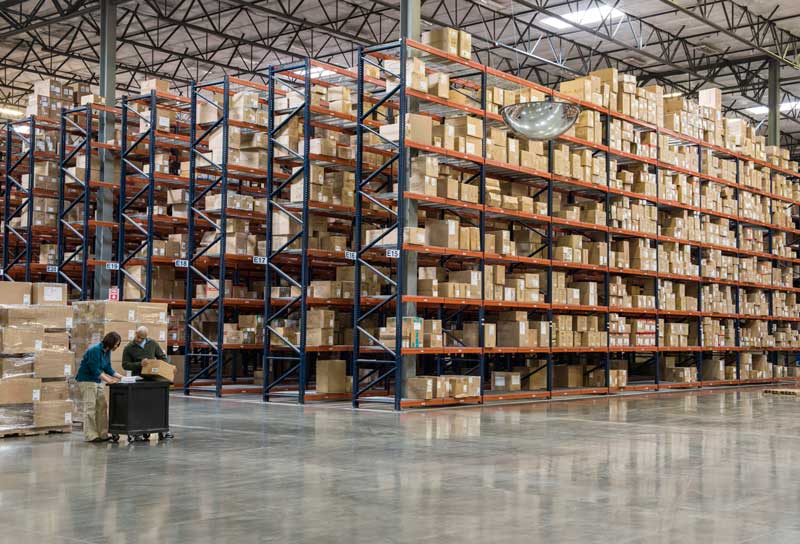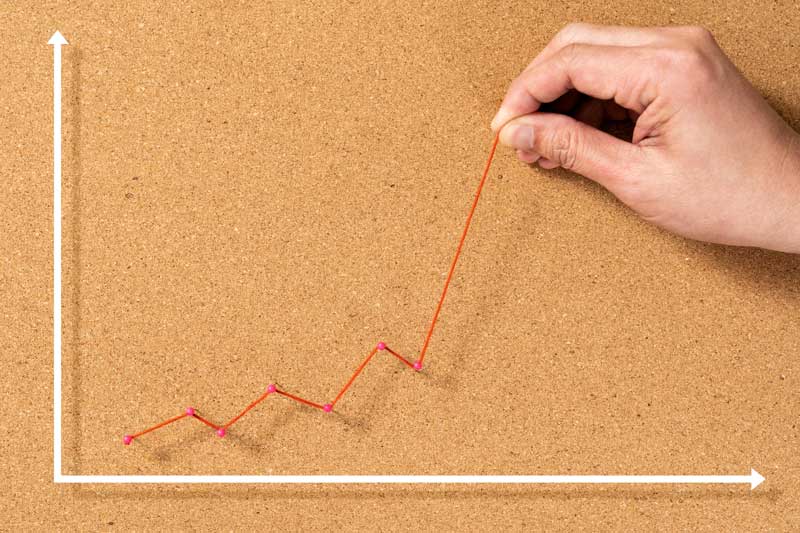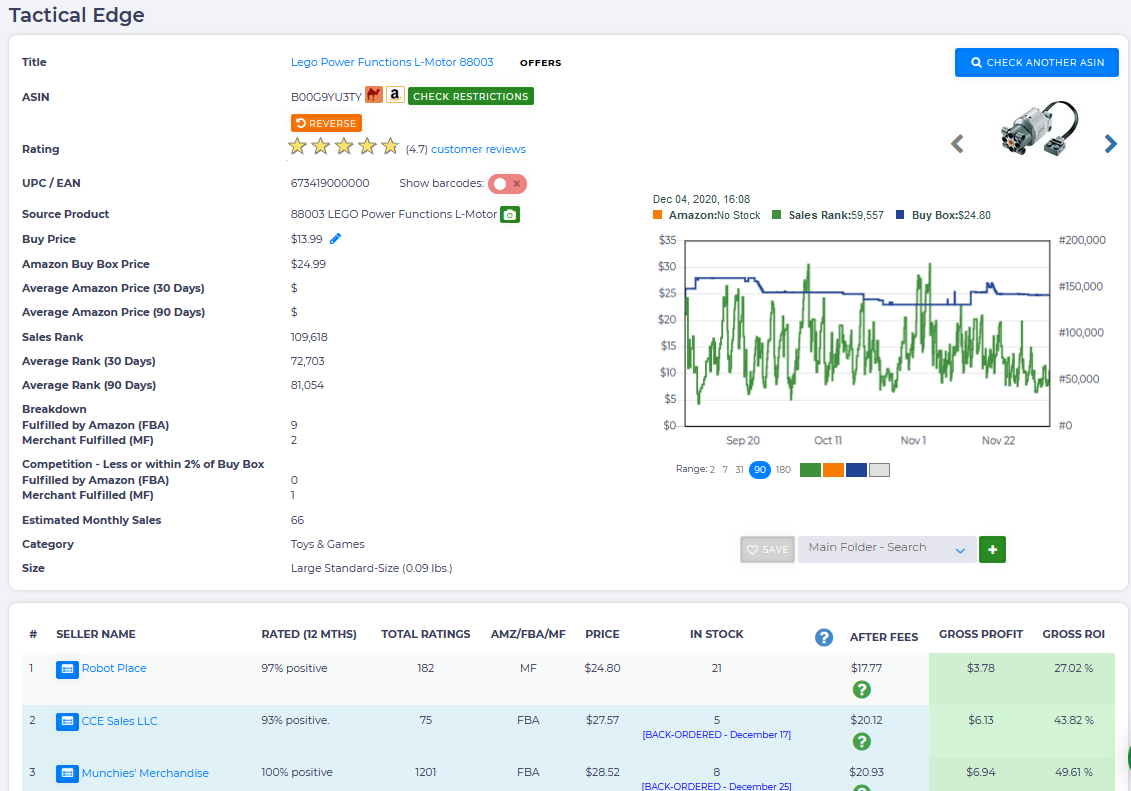Amazon continues to dominate the e-commerce sector in the U.S. with 38% of the market share, making the platform a central piece of any viable e-commerce strategy.
This dominance means each seller is competing with thousands of merchants on the platform – all vying to get the attention of customers on the marketplace.
One of the best ways to get the attention of buyers on Amazon is to be eligible to appear in the Buy Box. The Buy Box is so important because 82% of all sales on the platform come from the Buy Box.
In this article, I will help you unlock the mystery of the Amazon Buy Box, show you how you can be eligible for the Buy Box, and highlight the factors you must master before you can win the Amazon Buy Box.
What is the Amazon Buy Box?
Simply put: The Buy Box occurs when your product is the one that is purchased when the buyer clicks the “Add to Cart” or “Buy It Now” button.
All the items sold on Amazon have a product page with an “Add to Cart” section where customers can add the products they purchase to their cart. This section is the Buy Box.
Most buyers don’t take the time to look at all of the merchants on a given listing. They just want to buy the item and get it shipped to their house. That’s why the Buy Box is so important.
If you want to thrive as a merchant on Amazon, you want your listing in the Buy Box.
You can still sell items if you are not in the Buy Box, but you are missing out on a large share of the customers who are purchasing a given product every day.
The seller that wins the Amazon Buy Box is selected by the platform’s algorithm. The algorithm considers multiple factors when choosing the winning seller including pricing, customer service, fulfillment, shipping time, and others.
You have to understand the Amazon game (aka algorithm) in order to be competitive and have a chance at being placed in the Buy Box.

Amazon Buy Box Rotation
There is no fixed approved seller for the Amazon Buy Box. Amazon’s algorithm will rotate the Buy Box placement between the most eligible sellers for the Buy Box.
The only exception is when there is a single seller of an item (and sometimes Amazon doesn’t even put them in the Buy Box).
Eligibility depends on seller performance. I will discuss the requirements that are used to measure performance later in the article.
One other stipulation is that only new products can be placed in the Buy Box. If you sell used products, you will be excluded from the Buy Box.
One of the other interesting factors related to Buy Box placement is geography. Amazon wants to provide the quickest shipping possible, so it will sometimes place a product in the Buy Box because it is in a warehouse closer to the buyer.
Is the Buy Box Available For Every New Product Listed on Amazon?
No, it is not. The Buy Box will not show if none of the sellers offering the item are eligible for Buy Box placement.
Amazon will also remove the Buy Box if all the sellers offering the product are artificially controlling its price. That is, sellers are offering the product at a price above or below the average market price for the item.
Amazon does this to protect buyers and to ensure people aren’t rigging the system.
Is Amazon Always Guaranteed to Win the Buy Box?
Well, most of the time.
This is because when Amazon is offering the same product, they will naturally offer competitive prices and optimize their product listing to fulfill all performance-based requirements.
However, there are rare occasions where a merchant can offer better prices than Amazon combined with a top-rated seller performance.
In such a situation, Amazon may lose the placement to another seller.
How to Check if Eligible to Win the Buy Box
The basic requirements for winning the Buy Box are:
- A professional seller account
- An inventory of new products
- The product listed is in stock
- A history of successful sales on the platform
- High-performance metrics
If you fulfill the requirements listed above, you are eligible to compete for Buy Box placement.
You should know that meeting the minimum requirements does not guarantee you will win the Buy Box. It just gives you a strong likelihood of being placed in the Buy Box.
When there are multiple sellers offering the same product, only businesses that best optimize their operations will qualify for the Buy Buy rotation.
And this is a constantly changing list of possible sellers that will change as soon as a buyer views a product listing page.
To check your eligibility for the Buy Box, follow the steps listed below:
Step 1: Log in to your Amazon Seller Central account
Step 2: Click on the Inventory tab from the header menu
Step 3: Select Manage Inventory from the dropdown
Step 4: If you see the Buy Box Price and Buy Box Eligibility tabs, then you are fine
Step 5: If the tabs are absent, click the Preferences button in the top right-hand corner
Step 6: This will add the two tabs to the list along with checkboxes for you to select them
Step 7: Save your changes and go back to your Seller Central home page
To view your listed products that are eligible for the Buy Box, type Buy Box into the search bar of your Seller Central dashboard and navigate your cursor to the Help window that will be displayed on the right side of your window.

Factors to Win the Amazon Buy Box
Amazon doesn’t provide much information about the factors that go into its algorithm and no one except the company completely understands how Buy Box placement is allocated.
However, there are some factors that are universally acknowledged to be crucial to winning the Buy Box.
These factors are:
Seller Status
Like I mentioned earlier, only sellers that subscribed to a Professional Seller plan can be eligible for Buy Box. This subscription plan is for merchants that want to sell more than 40 units of their product a month and it costs $39.99 per month.
FBA sellers are given priority in Buy Box placement when they fulfill all the necessary performance-based requirements. To become an FBA seller, you must do the following:
You need to sign up for an Amazon seller account. You can do that here.
Think about an account as giving yourself a shelf in the store we call Amazon.
A seller account gives you access to the Amazon marketplace and gives you the ability to list inventory for sale. Your Amazon seller account also gives you access to the FBA services that I was mentioning above.
Competitive Prices
Aim for competitive pricing that puts you within 5% of the average marketed price for the listed product. Amazon prioritizes low prices above all else. Which makes sense as it makes the customers happier.
Having the lowest price will not guarantee product placement. Instead, you target product prices that are competitive while also helping you achieve profitability.
Shipping Time
The faster you can get your products to your buyers, the better your chances of securing the Buy Box placement.
Amazon has invested billions into building a logistics ecosystem that guarantees fast delivery & this stands to benefit third-party sellers.
Customers have become accustomed to this standard, and Amazon expects sellers on its platform to match its pace.
Amazon’s shipping categories include:
- 0 -2 days
- 3 -7 days
- 8 -13 days
- 14 or more days
Moving to a 0 -2 days category or any other category that is much faster than your current category will have a big impact on your performance metrics.
You must also deliver your products on time. The ideal on-time shipping rate to target is anything above 97%.
We recommend using Amazon FBA, but that’s your call.

Inventory Levels
There is no Buy Box placement for a merchant that is out of stock. Amazon will prioritize merchants with inventory levels that ensure fast fulfillment and you may also be excluded from the Buy Box when you are low in stock.
This makes tracking your product inventory levels very important. You can use the Amazon Selling Coach on your Seller Central homepage to set up low stock alerts.
In-Stock Consistency
If you are the type of merchant that is frequently out of stock, Amazon will remove you from the Buy Box rotation. They want the products to sell (since they make money when a transaction occurs), so they want to show listings that are consistently in stock.
Your overall consistency with maintaining adequate inventory levels is just as important as your inventory status for the current period.
Fulfillment Method
Do you use Fulfillment by Merchant (FBM), Fulfillment by Amazon (FBA), or Seller-Fulfilled Prime (SFP)? Your choice of fulfillment method is one of the most important factors that will influence your chances of securing Buy Box placement.
Merchants that use FBA have a much better chance of getting onto the rotation than merchants that manage shipping in-house.
Valid Tracking Rate
This measures the percentage of products you ship that have valid tracking. It considers the packages you have shipped in the last seven or 30 days.
You should aim for a minimum valid shipping rate of 95% if you want to be eligible for the Buy Box. If you are using FBA, this does not apply to you.
Order Defect Rate
This measures the percentage of the orders you fulfilled that received negative feedback over a 60 day period. Amazon will look at credit card chargebacks, A-to-z claims, seller ratings, and negative comments.
Your Order Defect rate must be less than 1% if you want to continue selling products on the platform. If you want to get onto the Buy Box rotation, aim for a 0% order defect rate for your product listing.
Customer Response Time
Aim to respond to all customer queries within 12 hours and make sure you respond to at least 90% of all customer messages.
Amazon requires all merchants to respond to customer questions within 24 hours and the algorithm will check your responses over the last 30 days when evaluating your eligibility for Buy Box rotation.
Return Dissatisfaction Rate
It measures customer satisfaction with how you responded to their return requests. It is the percentage of negative return requests from the total return requests.
If a return request is incorrectly denied or if the request was not processed within 48 hours, it will be classified as a negative return request. A return request with negative customer feedback will also be classified as a negative return request.
Merchants are rated either Good, Fair, or Poor. You must be rated Good to get on Buy Box rotation.
Customer Service Dissatisfaction Rate
This is the percentage of customers that are unhappy with a merchant’s responses in Buyer-Seller messaging.
Anytime you respond to a customer message about an order, Amazon will give the buyer a survey asking “Did you solve this problem?” and they can respond “Yes” or “No”.
The customer dissatisfaction rate will be the percentage of “No” votes from the total number of responses. You can be rated either Good, Fair, or Poor. I don’t really need to tell you that you need to be rated Good to get a Buy Box placement.
Time on Amazon
The length of time you have been selling on the platform also influences your Buy Box Placement. The longer you have been on the platform, the more data Amazon’s algorithm will have to evaluate your performance metrics.
Amazon needs time to familiarize itself with you as a merchant, and chances are new sellers will not find it easy to get onto the Buy Box rotation.

Buy Box Optimizations Tips
You can see the factors above that Amazon uses to select merchants for the Amazon Buy Box. Now let’s look at how you can optimize your operations to secure a place in the Buy Box rotation for your product listings.
Below are some Buy Box optimization strategies you can adopt:
1. Optimize Your Product Pricing
Competitive pricing is possibly the most important requirement for getting a Buy Box placement. The keys to keeping your prices competitive are excellent business operations and market intelligence.
Market intelligence is important because you must be able to constantly adjust your prices to ensure you remain within the range of prices offered by other merchants selling the same product.
Fortunately, Amazon provides merchants with an Automate Pricing tool that enables repricing. With this tool, you can set rules that ensure your product prices will automatically adjust to events.
This repricing tool uses powerful algorithms to help you utilize your market intelligence to compete on your own terms. There are other third-party repricers like RepricerExpress and Xsellco that will do the job perfectly and give you more customization options.
You can access Amazon’s Automate Pricing tool directly from your Seller Central dashboard. Click the “Pricing” tab and select “Automate Pricing”.
On the tool’s homepage, click the “Create a customized Pricing rule” to select the rule you wish to apply to your products from the dropdown.
You can choose from five types of pricing rules including:
- Competitive buy box: this prices your product below or above the current Buy Box price for your product
- Competitive lowest price: this sets your price as the lowest among all the available listings
- Competitive external price: this sets your price to align with the average non-Amazon market price
- Based on sales unit: this lets you set a price for a fixed number of units from your inventory
- Price synchronization: this lets you adjust your pricing for all your product listing tiers to align with a standard price
After choosing your rule, enter a rule name, and select the marketplaces where you want the rule to apply.
When you are done responding to all the prompts, click “Save this rule”.
When using Amazon’s Automate tool, the rules will only apply to the SKUs you have selected and not to your entire product catalog. You must also set a maximum and minimum price. If you don’t select a maximum price, the tool will ensure your product is not priced significantly higher than the average market price.
Competitive pricing relies on excellent market research and here are a few tips to help you use your research data effectively:
- Shipping times: analyze the in-stock consistency of your competitors and price your products higher when your primary competitors are most likely to have low inventory levels. When they have high inventory levels, price your product lower.
- Fulfillment method: if the majority of your competitors are using FBM and you are using FBA, price your product slightly higher. If you are all using FBA, focus on other strategies.
- Feedback: If you have a higher customer feedback rating than your competitors, price your product slightly higher. If your feedback rating is lower, price your product lower than your highest performing competitor.
- Profit: the reason why every business exists is to make profits. Watch your margins and don’t price your product so low that you will be selling at a loss.
2. Master Customer Support
Top-rate customer support is essential to winning the Buy Box. The happier your customers are with your customer care services, the better your metrics will be.
Here are a few tips to help you master customer support:
- Customer support documentation: anticipate the needs of your customers and make all the information they need for each stage of the buying process available on your product page. On your product page provide information about your refund policy, shipping policy, returns policy, and warranty information.
- Speed: buyers want you to respond to their queries as quickly as possible. Any response after 24 hours is likely to attract negative feedback. You can speed up your response time by creating automated reply templates for the most popular customer questions. Work with your customer support staff to identify the most popular customer questions.
- Personalization: the way you phrase your messaging is just as important as the speed of your response time. Personalize your messaging and leverage historical purchase data to provide tailored support for each customer.
3. Solicit Positive Feedback
Seller metrics like Customer Satisfaction Rate and Customer Service Dissatisfaction Rate all measure your reputation. Your reputation is shaped by the amount of positive feedback you receive from customers.
If you get too many negative feedbacks, it will have a severe impact on your chances of getting a Buy Box placement.
Here are a few tips to help you get more positive feedback from customers:
- Exceed the expectations of your customers: the secrets to getting positive feedback are top-quality products and excellent customer support. Do list defective products that will fail to meet the expectations of buyers and attract negative reviews.
- Be selective when requesting customer reviews: only request reviews from your most loyal customers. Focus on products that have sold well to ensure a large pool of buyers that have had the chance to use the product.
- Respond to every customer review: respond to positive reviews to show loyal customers your appreciation and to encourage them to leave more reviews in the future. You must also respond to every negative review. Address the complaint of each customer and apologize whenever you are responsible for the incident.
4. Track Your Buy Box Performance
You can track your Buy Box performance from your Seller Central dashboard. Log in to your page, at the top of your window you will see the Buy Box Wins metric tab.
The metric is calculated by dividing the number of page views obtained by the product page by the number of times you won the buy box.
For example, if the product page was visited 500 times in a seven-day period, and you won the Buy Box 100 times, your win percentage will be 20%.
You can also view your Buy Box metrics for each marketplace you sell in by clicking on the tab.
5. Leverage the Power of Third-Party Tools
There is a wide range of software apps that can help you get the market intelligence and data you need to make better business decisions.
Some insights you can gain from using these tools include:
- How many merchants are competing for the Buy Box on your product page
- Who is dominating the Buy Box rotation and why
- How well are you performing in the Buy Box rotation
- Why are you losing the Buy Box to other competitors
- How can you schedule your price changes to take advantage of market trends and changing competitor inventory levels
- How to leverage the power of online arbitrage to maximize profits
- How to track your pricing history of your competitors
Leverage Tactical Arbitrage – Tactical Edge Feature
There is one tool I love to use when I am scouting out my competition. That’s Tactical Edge from Tactical Arbitrage.
It helps give you the necessary data to get inside the head of your competitors and find out why they might have the upper hand on the Buy Box.
It gives you this powerful data to help you source & win the Buy Box:
- Seller Rating
- Total Ratings
- Fulfillment
- Price
- How many in Stock
- Profit & ROI
You can give Tactical Edge a whirl with a free trial. Check it out here. Or you can learn more about it here.
Final Thoughts
As you can probably tell by now, winning the Buy Box is possible if you master the requirements that Amazon uses for Buy Box placement and optimize your operations to meet those requirements.
Now, it’s up to you to use the knowledge you have gained from this article to optimize your operations and get your product listings onto the Buy Box rotation.
Related Questions
Why is there no buy box on Amazon?
The Buy Box on a product page will be removed if the sellers are engaging in unfair pricing practices. It will also be removed if none of the sellers are eligible for Buy Box placement.
How do I get the Buy Box on Amazon?
You can get a Buy Box placement for your product if you meet the eligibility requirements. These requirements include:
- Professional seller status
- Listing new products
- Having excellent seller performance metrics
- Strong inventory levels
- Competitive prices
Does FBA always get the Buy Box?
Most of the time. More often than not FBA sellers will get Buy Box placement over FBM sellers.


